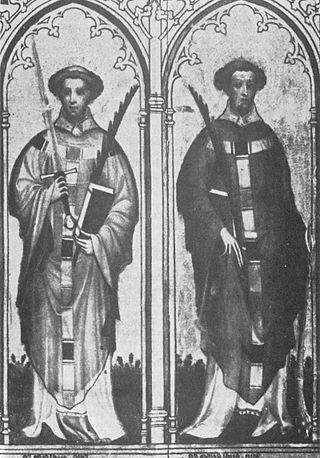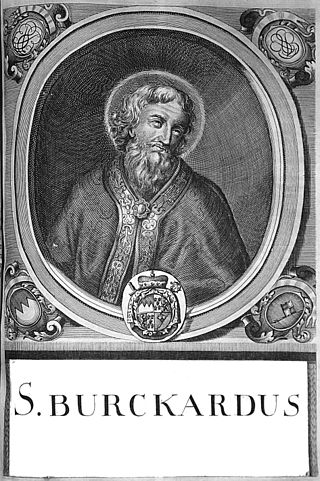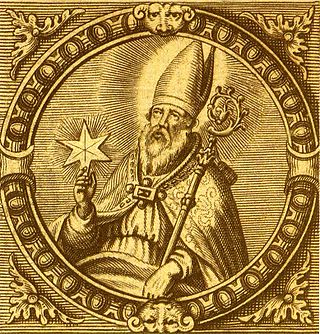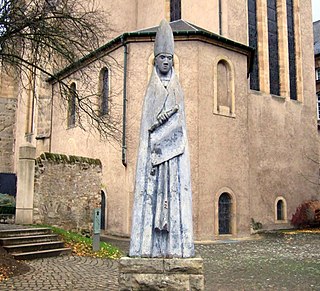Pope Boniface V was the bishop of Rome from 23 December 619 to his death. He did much for the Christianisation of Anglo-Saxon England, and enacted the decree by which churches became places of sanctuary.

Boniface was an English Benedictine monk and leading figure in the Anglo-Saxon mission to the Germanic parts of Francia during the eighth century. He organised significant foundations of the church in Germany and was made bishop of Mainz by Pope Gregory III. He was martyred in Frisia in 754, along with 52 others, and his remains were returned to Fulda, where they rest in a sarcophagus which remains a site of Christian pilgrimage.

Year 735 (DCCXXXV) was a common year starting on Saturday of the Julian calendar. The denomination 735 for this year has been used since the early medieval period, when the Anno Domini calendar era became the prevalent method in Europe for naming years.

Willibrord was an Anglo-Saxon monk, bishop, and missionary. He became the first Bishop of Utrecht in what is now the Netherlands, dying at Echternach in Luxembourg, and is known as the "Apostle to the Frisians".
Ecgberht was an Anglo-Saxon monk of Northumbria. After studying at Lindisfarne and Rath Melsigi, he spent his life travelling among monasteries in northern Britain and around the Irish Sea. He was instrumental in the establishment of Wihtberht's mission to Frisia.

Willehad or Willihad ; c. 745 AD – 8 November 789) was a Christian missionary and the Bishop of Bremen from 787 AD.

Wigbert, (Wihtberht) born in Wessex around 675, was an Anglo-Saxon Benedictine monk and a missionary and disciple of Boniface who travelled with the latter in Frisia and northern and central Germany to convert the local tribes to Christianity. His feast day is August 13 in the Roman Catholic Church and the Eastern Orthodox Church.

Ludger was a missionary among the Frisians and Saxons, founder of Werden Abbey and the first Bishop of Münster in Westphalia. He has been called the "Apostle of Saxony".

Gregory of Utrecht was born of a noble family at Trier. He became a follower of Saint Boniface, who sent him to study at the Monastery of Saint Michael at Ohrdruf. He then accompanied Boniface on his missionary journeys. In 750, Boniface appointed Gregory abbot of St. Martin's Monastery in Utrecht. St. Martin's became a centre of learning and missionary activity. When, in 754, Eoban left to accompany Boniface on their last missionary trip, Gregory was tasked with administering the diocese of Utrecht, which he did faithfully for the next twenty-three years until his death in 776.

The Two Ewalds were Saint Ewald the Black and Saint Ewald the White, martyrs in Old Saxony about 692. Both bore the same name, but were distinguished by the difference in the colour of their hair and complexions. They began their mission labours about 690 at the ancient Saxons country, now part of Westphalia, and covered by the dioceses of Münster, Osnabrück, and Paderborn. They are honored as saints in Westphalia.

In the seventh century the pagan Anglo-Saxons were converted to Christianity mainly by missionaries sent from Rome. Irish missionaries from Iona, who were proponents of Celtic Christianity, were influential in the conversion of Northumbria, but after the Synod of Whitby in 664, the Anglo-Saxon church gave its allegiance to the Pope.

Saint Burchard of Würzburg was an Anglo-Saxon missionary who became the first Bishop of Würzburg (741–751).

The Abbey of Echternach is a Benedictine monastery in the town of Echternach, in eastern Luxembourg. The abbey was founded in the 7th century by St Willibrord, the patron saint of Luxembourg. For three hundred years, it benefited from the patronage of a succession of rulers, and was the most powerful institution in Luxembourg.

Saint Suitbert, Suidbert, Suitbertus, Swithbert, or Swidbert was born in Northumbria, England, in the seventh century, and accompanied Willibrord on the Anglo-Saxon mission.

Willibald was an 8th-century bishop of Eichstätt in Bavaria.

Boisil was a monk of Melrose Abbey, an offshoot of Lindisfarne, then in the Anglo-Saxon Kingdom of Northumbria, but now in Scotland, where he must have been one of the first generation of monks. He probably moved to the new foundation of Melrose when it was started, some time in the late 640s.
Rath Melsigi was an Anglo-Saxon monastery in Ireland. A number of monks who studied there were active in the Anglo-Saxon mission on the continent. The monastery also developed a style of script that may have influenced the writers of the Book of Durrow.

The Frisian Kingdom is a modern name for the post-Roman Frisian realm in Western Europe in the period when it was at its largest (650–734). This dominion was ruled by kings and emerged in the mid-7th century and probably ended with the Battle of the Boarn in 734 when the Frisians were defeated by the Frankish Empire. It lay mainly in what is now the Netherlands and – according to some 19th century authors – extended from the Zwin near Bruges in Belgium to the Weser in Germany. The center of power was the city of Utrecht.

Christianity in the 8th century was much affected by the rise of Islam in the Middle East. By the late 8th century, the Muslim empire had conquered all of Persia and parts of the Eastern Roman (Byzantine) territory including Egypt, Palestine, and Syria. Suddenly parts of the Christian world were under Muslim rule. Over the coming centuries the Muslim nations became some of the most powerful in the Mediterranean basin.

Wilgils of Ripon, also known as Wilgisl and Hilgis, was a seventh century saint and hermit of Anglo-Saxon England, who was the father of St Willibrord. His feast day is 31 January.


















